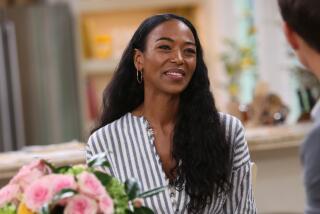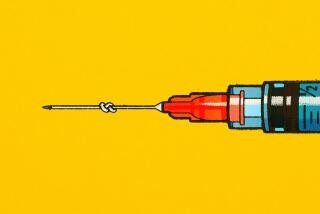Implants Made Them Feel Like Unnatural Women
- Share via
The idea of beautiful breasts has changed over time.
In the 1950s, the ideal was pointy; for the next two decades it was small and free; in the 1980s and ‘90s, big and round; and now from actress Pamela Anderson Lee, an unlikely role model, comes the message that natural is beautiful.
For the record:
12:00 a.m. May 7, 1999 For the Record
Los Angeles Times Friday May 7, 1999 Home Edition Southern California Living Part E Page 3 View Desk 1 inches; 32 words Type of Material: Correction
Implant surgery--In a story April 30 about breast implant removals, the number of breast augmentation surgeries performed in the United States in 1998 should have been reported as 132,378. That was a 306% increase from 1992.
Two weeks ago, the 31-year-old Lee announced that she had her implants removed to return to a more natural state. The actress, who declined a Times request for an interview, talked about her decision on “Entertainment Tonight” last week. She said she did it for personal, not health, reasons.
Beyond the snickers and late-night TV jokes about Lee lie a serious medical procedure and psychological adjustment for women who elect to reverse their breast augmentations. Lee’s decision to go public brings a new awareness about breast reduction.
Although there’s no data on the number who have removed implants, more women may one day grapple with such a decision. The American Society of Plastic and Reconstructive Surgeons reported 182,378 women underwent breast augmentation in 1998, a 306% increase from 1992.
Dr. James P. Watson, assistant professor of plastic surgery at the UCLA School of Medicine, says, “As of today, the American Society for Plastic and Reconstructive Surgeons, the FDA and most other medical societies such as the AMA state the only medical reason to have an implant removed is if you have a ruptured implant. If it is not ruptured, it does not have to be removed.”
Most people who come to UCLA for implant removal, Watson says, are suffering from pain or have a ruptured implant. Sometimes, a woman who has had two or three implant replacements will decide to have them taken out.
The decision to remove implants is as personal as, and perhaps more difficult than, deciding on breast augmentation. The reasons range from health concerns to just wanting a more natural shape. Lee told “ET” that she was tired of looking “like Dolly Parton.”
Lee’s candor may be earning her new fans.
“I think she has an incredible chance to be such an amazing role model for women,” says actress Mary McDonough, who played Erin on the TV series “The Waltons.” “The fact that if she owns her natural body, she is still beautiful . . . helps women embrace their own bodies.”
McDonough, 37, is one of several celebrities who have had their implants removed. Singer Courtney Love says she had her implants removed. Mariel Hemingway and Sally Kirkland had theirs removed as well.
For McDonough, getting implants at age 22 “was partially a young foolish decision, the other half of it was a career decision.” She thought that as she moved out of the child acting niche into mainstream Hollywood, bigger breasts would help her get more work.
“That’s what I thought sexy was,” she says.
The irony is that since she had her implants removed three years ago, “I’ve gotten healthier. I have smaller breasts than I ever had before. I’m working more than I have in 10 years.”
*
McDonough, who has made recent guest appearances on “Diagnosis Murder,” “Ally McBeal,” “ER” and “The Pretender,” says, “I think that there’s enormous pressure on women and how they look, and it’s not just in Hollywood. It goes into every high school and every junior high.”
Although research has found no connection between silicone gel breast implants and health problems, McDonough says she thinks she was allergic to the silicone gel and attributes her problems with lupus to that. When she wanted to have the implants removed, her surgeon advised her to have them replaced with saline-filled ones. She told him, “I’m over the big boob thing. Just take them out.”
Her breasts are much smaller than they were originally, but she is happy with them, saying it was all about “finding my own sense of being female and being a woman, and it had nothing to do with my breasts.”
Breast augmentation is a fairly simple procedure. A silicone bag is inserted, in most procedures, behind the main chest wall muscle (pectoralis major) and then filled with saline. The FDA no longer permits silicone gel-filled implants except in certain trial situations.
Most women are happy with their breast implants, says Dr. Malcolm D. Paul, a Newport Beach plastic surgeon who has done more than 1,000 breast implants in his 24-year career. Of those, only 10 have come back to have their implants removed. Paul discourages women from taking them out unless an internist has recommended it for medical reasons.
When an implant is removed, it leaves a cavity and, depending on the woman, can leave the breast looking hollow and wrinkled. UCLA’s Watson says a woman has five options: implant removal alone; removal of the implant and surrounding scar tissue (capsulectomy); implant removal and breast tuck (mastopexy, which McDonough selected); implant replacement; or reconstructing the breast with a woman’s own tissue from her back or abdomen.
The most radical surgery, reconstruction using a woman’s own tissue, is usually performed on cancer patients who have had implants after mastectomies and later want the implants removed, Watson says. It is a complicated, long surgery with major anesthesia, and it has more medical risks and costs than a simple implant replacement.
The reconstruction surgery costs about $30,000 or more. Insurance will cover only the implant removals. The cost of any further cosmetic surgery comes out of the patient’s pocket, unless she has had a mastectomy, Watson says.
Perhaps no other part of the body is as significant for a woman’s sense of beauty, sensuality and even motherhood than her breasts.
Whether a breast change is done for self-esteem or medical necessity, it makes an indelible mark on a woman’s psyche.
“Women undergoing cancer treatment really have been assaulted from all levels,” says Dr. Anne Coscarelli, director of the Rhonda Fleming Mann Resource Center for Women With Cancer at UCLA.
“Beauty is a limited word and how we talk about it. It’s not just beauty, it’s self-image and our image as a woman,” she says. “The breast has many different meanings in our culture. We come from a society where we put great value on women’s breasts.”
*
Women who have undergone cancer treatment have either lost a breast to surgery or their hair to chemotherapy. And any decision a woman makes to regain her original beauty should be supported in a “nonjudgmental way,” Coscarelli says. “I don’t think any of us can judge what’s right for anyone else.”
For Anne Stansell, what was right at age 39 was to take her doctor’s advice and have reconstructive surgery with implants one year after she lost two breasts to cancer. The Los Lunas, N.M., photographer later decided the implants were jeopardizing her health, so she had them removed and returned to a chest without breasts in 1995.
“I felt more natural than before,” Stansell says. “The implants don’t feel natural at all.” Since then, the 51-year-old has devoted her work to photographing women around the country who have had implants removed.
Married with two grown children whom she breast-fed, Stansell says her ideas about her breasts have changed throughout the years, as have those of most of the women she has photographed. In fact, after their implants were removed, most of her subjects said they felt they had regained their beauty.
Perhaps that’s why Lee’s honesty resonates with other women. As UCLA’s Coscarelli says, “It opens up the discussion for other people and it puts that discussion on the table, and I think she has done that for many women. Whenever you discuss those things, it’s a good thing.”
Barbara Thomas can be reached by e-mail at [email protected].


